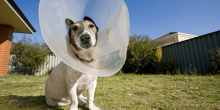By Dr. Heather Kovac
The Patient
Skipper, a 7 year old female German Shepherd, came to see me for a lump on her belly. Her owner had noticed a lump developing under the skin in her mammary [breast] area. The mass had been slowly getting larger and was now about the size of an orange but did not seem to bother her. It had been there for about 1 year.
The Case
On presentation, there was a very firm subcutaneous [under the skin] mass that was hanging down from her 3rd right mammary gland. Dogs typically have 10 nipples and 10 mammary glands, five on each side of the ventral thorax and abdomen. There is some variation between dogs but the average number is 10. Both female and male dogs have nipples but only female dogs develop mammary tissue unless they are spayed prior to their first estrus [heat cycle]. Skipper was intact, meaning she had not yet been spayed. She had never been bred or had puppies. Female dogs typically go into heat between 9-12 months of age and then cycle every 6 months year-round. Spayed females do not have heat cycles and do not develop breast tissue.

The Treatment Plan
I recommended a fine needle aspirate of the mass on Skipper’s belly to determine what type of tumor it was. This means that a thin needle is inserted into the mass to collect some cells from the tumor and then placed on a glass slide and examined under the microscope. Skipper’s mass was confirmed to be a mammary tumor and I recommended surgical removal. I also collected a blood and urine sample to run some routine laboratory tests to ensure she was in good metabolic health for anesthesia and surgery. I also took an xray of her chest to ensure the mass had not metastasized [spread] to her lungs—it had not. Her labwork was normal and her surgery was scheduled for the following week.
In addition to removing the mammary mass, I spayed Skipper while she was anesthetized. Dogs spayed prior to their first heat have 0.5% of the risk of developing mammary cancer compared to intact female dogs. Dogs who go through just one heat prior to being spayed have 8% of the risk and dogs going through 2 or more heats have 26% of the risk. Ovarian hormones irreversibly predispose mammary glands to tumor development. Skipper will still be at risk of developing more mammary masses down the road but she will no longer go into heat every 6 months. Thankfully, her tumor turned out to be a benign mixed mammary tumor and not the more aggressive malignant type. About 50% of mammary tumors are benign and 50% are malignant. She recovered well from her procedure after taking it easy for about 10 days.
The Takeaway

We highly recommend having female dogs spayed prior to their first heat cycle with very few exceptions. The word “spay” is the common name for ovariohysterectomy. This means that both ovaries and the uterus are removed surgically. This surgery prevents pregnancy, eliminates heat cycles, prevents ovarian and uterine cancer, prevents uterine infections [pyometra], and significantly reduces the risk of breast cancer in dogs. Young dogs recover very quickly from this procedure and are back to themselves within a few days.
Please talk with your veterinarian about having your dog spayed today! You can schedule your pet's next appointment here.
The Drake Center for Veterinary Care is an AAHA-accredited animal hospital located in Encinitas, CA. The Drake Center loves being a source of information for all pet owners across the country however if you have any questions regarding pet care and do not live in Encinitas, CA or surrounding cities, we encourage you to contact your local veterinarian.

